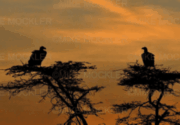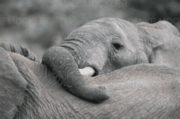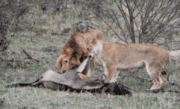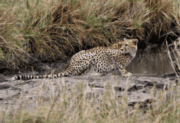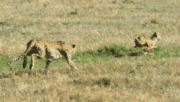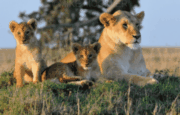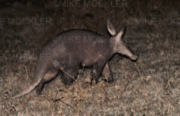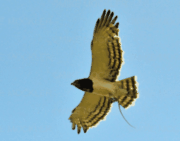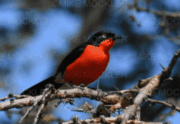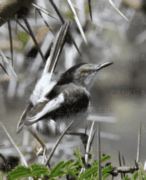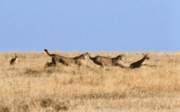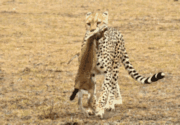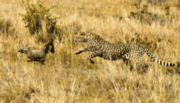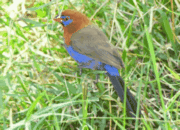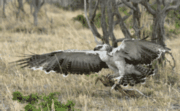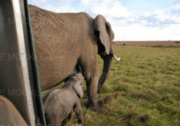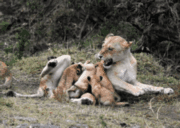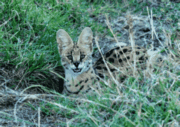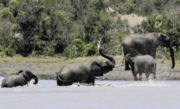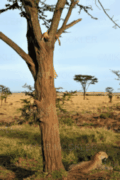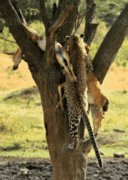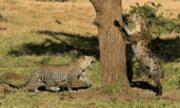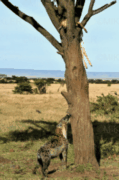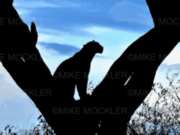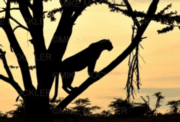|
Mike Mockler Kenya 2016 |
October 2016 In the rainy season a year ago, the Masai Mara was inundated with deluge after deluge. Safari camps were washed away, vehicles were stuck in the mud and small streams became surging torrents. It was an "El Nino year". A year later and I arrived with my group to find the rains overdue, the Mara parched and dusty and the streams now stagnant pools. Only to be expected - perhaps - in the year following El Nino. As on other recent Kenya tours, I had decided to use small, intimate camps in the Mara conservancies that are far less crowded than the Masai Mara Reserve itself and contain a dazzling array of wildlife. In fact, many species are regularly seen very close to camp - or even in camp - including elephants, giraffes, zebras, impalas, elands, buffalos, wildebeest, warthogs, topis, leopards and lions. Cheetahs provided some of the most exciting moments of the tour. We witnessed no fewer than four cheetah hunts, two of which were successful. Three young cheetahs put on a sensational chase that exploded almost without warning around our vehicles. With the female taking the lead, they combined to catch a young impala so quickly no-one had time to take photos. The next time we came across this young female, she had parted company with her two brothers and was hunting alone. She twice tried to catch a young impala, failing on both occasions because the terrain was so rocky she was unable to risk top speed. We enjoyed several encounters with a cheetah mother, known as Amani, and her two lively cubs that provided great entertainment, chasing each other around and jumping up into trees. On our final meeting with them they posed for photos on termite mounds, drank from a small pool and then pursued a really annoying silver-backed jackal. Amani started the fun with the initial chase, though she barely got out of second gear, and then her cubs took over and gave the jackal a fright as they very nearly caught it. There was unforgettable drama involving two leopards (a mother, known as Nalangu, and her well-grown son). We had already seen Nalangu three times and we knew she had a young eland carcass cached in a tree. When we found her again, she was leading her son across the plain towards the tree containing her kill. Little did they (or we) know that a pride of lions was hidden in the bush nearby. The events that followed were dramatic. The leopards were attacked by the lions and were lucky to escape serious injury. None of us will forget the speed the young male rocketed up a tall, slim tree or the sight of him 45 feet up swaying to and fro each time he moved. After the lions had moved off, he had to work out how to get back down and we all held our breath each time he tried to climb down the vertical trunk head first - a potentially fatal manoeuvre. Eventually, the flimsy branch he was sitting on snapped, gravity made the decision for him and he slithered down backwards. With so many depressing reports about the decline of Africa's lions, it was a joy to see lions in healthy numbers, many with young cubs. In particular, it was encouraging to find many mature males. In other African countries, where commercial trophy hunting safaris target the big males, it is a very different story. Kenya has not permitted commercial hunting since 1977 and deserves huge credit for that. On our first afternoon, a mating pair of lions roused themselves from their slumbers and started to take an interest in passing animals, in particular a line of wildebeest. Immediately, the lioness began to stalk them and, in next to no time, she grabbed an adult wildebeest. She settled down to feed with the male lion but, after a short period of feeding amicably together, he decided to claim the kill for himself. Male lions care little for fairness and decency! At a time when ivory poaching is devastating elephant populations elsewhere in Africa, it was wonderful to see many herds of elephants. Most contained small calves and were relaxed. In areas where poaching is occurring, elephants are invariably extremely nervous and unpredictable. On night drives, we saw aardwolf, striped hyena, porcupine, genet, white-tailed mongoose, spring hares, bat-eared foxes, zorillas, lesser galagos (lesser bushbabies) and that Holy Grail of Africa's mammals, the aardvark. In fact, on this trip, we had TWO outstanding sightings of this rarely-seen animal. Bird-watching was good throughout the tour - as it always is in Kenya - though the number of bird species recorded was slightly down on previous years, largely because fewer migratory birds were seen. At the start of the tour, migration was well under way - Barn Swallows, European Bee-eaters, Montagu's Harriers, Steppe Eagles, Northern Wheatears and Red-backed Shrikes - but the numbers of migrants didn't increase much thereafter, probably because the dry conditions were encouraging most migrants to continue their journey south in search of greener pastures. Other key species seen included Pygmy Falcon, the gorgeous Violet-backed Starling, Martial Eagle, Bateleur Eagle, Long-crested Eagle, Black Cuckoo-Shrike, Black-headed Oriole, Greater and Scaly-throated Honeyguide, Gabar Goshawk, Lizard Buzzard, White-backed Duck and Purple Grenadier. On one occasion, a Black-chested Snake-Eagle circled above us with a spotted bush-snake in its talons. There were also two major ornithological highlights. The first involved a species that one would not expect to see in the Masai Mara. This was the unmistakable Black-headed Gonolek, a colourful, striking species I had never seen in Kenya (having only encountered it in Uganda, where it is quite common). An even rarer species was the tiny Karamoja Apalis, which current field guides show as not occurring anywhere in Kenya, though there have been a few records there. It is found in the semi-arid northeastern Karamoja region of Uganda and in a small area in Tanzania. This vulnerable species has a distinctive way of cocking its tail and favours Whistling Thorn (Acacia drepanolobium), the habitat in which it was foraging when we saw it. Two handsome male cheetahs treated us to one of the most dramatic cheetah hunts I have ever witnessed. What's more, it was all clearly visible from start to finish. The unfortunate victim was a feisty female impala that should have been an easy catch for such experienced cheetahs but the chase went on much longer than expected. The water-hole in front of our camp was frequently visited by herds of elephants and we were treated to wonderful elephant-viewing as they drank and bathed, splashing around in the water like children, sometimes totally submerged. At the end of our stay, the elephants reappeared as we said our farewells. *********** A month later I was back in the Masai Mara conservancies, this time on a private safari. I was hoping the plains would now be a vibrant green but as we flew into the airstrip, I saw miles and miles of parched grassland. The desperately-needed rains had still not arrived. We relocated Amani and her two cubs, now even more adventurous, leaping into even taller trees. On one occasion, the female cub spotted an impala from her lofty perch in a tree. She quickly descended to stalk the impala and nearly caught it, while her mother looked on, apparently impressed by her daughter's precocious hunting skills. The next day, they encountered a troop of baboons, potentially lethal adversaries. Undeterred, the two cubs teased and chased the baboons, risking life and limb. We met another cheetah mother, known as Musiara, with three almost fully grown cubs. One of the five hunts we watched resulted in the capture of a young Thomson's gazelle, while another saw two bat-eared foxes escape death by inches. Bird-watching was slightly better than in October as a few more migrants had arrived from the north including White and Abdim's Storks, Pied Wheatear and Lesser Kestrels. The Black-headed Gonolek was still in the same place as in October and there were plenty of other interesting sightings: a flock of nearly 100 Yellow-throated Sandgrouse and an immature Martial Eagle on the ground with a gazelle carcass that was so heavy the eagle was unable to take off with it in its talons. We had numerous enjoyable close encounters with elephants. The most memorable came when a large female with a tiny calf wandered right up to us and continued to allow her calf to suckle while she virtually leaned against our Landcruiser. Usually, elephant mothers are very wary and protective with a small calf but this cow was incredibly relaxed in our presence. It was extraordinary to watch the tiny calf suckling noisily just a foot or two away from us. Baby animals were everywhere: topis, impalas, gazelles, warthogs, giraffes, lions and hyenas. It was that time of year. Three lionesses fed their young in a secluded river bed. One of them had four-month old cubs while the other two had six cubs between them that were only about three weeks old. Although the mothers shared the feeding, often the cubs all piled onto one lioness, fighting over the teats and, judging by the lioness's angry reaction, causing her some pain with their sharp little teeth! The most intriguing event came when lions killed a wildebeest and surprisingly some buffalo bulls drove the lions off the fresh carcass and would not allow them to continue feeding. For some time there was a stand-off with one buffalo standing over the dead wildebeest and defying the lions. Eventually the buffalos lost interest and ambled off, allowing the lions to move in and feed on the wildebeest. Compared to their larger, more celebrated cousins, servals may seem less impressive but these elusive little cats are absolutely delightful. One of the stars of our trip was a beautiful serval that we watched for most of one afternoon as she hunted for small birds and rodents. She made a couple of unsuccessful pounces on unseen prey in the long grass but we were full of admiration for her elegance, patience and stealth. Another star was a young male leopard, known as Olare. We watched him on numerous occasions and were hugely impressed by his extraordinary achievements for one so young. One morning, we found him at the base of a tree with a young topi kill and then realised he had another young topi already in the tree - not to mention a third kill, a young zebra, hidden under a nearby bush! We watched him struggle to haul the second topi up the tree which involved a massive effort as he had to drag it up and over the first kill which was blocking access to the upper part of the tree. On the following day, we found Olare had been joined by a hyena. The young zebra carcass had gone, probably stolen by the hyena, but both topi carcasses were safe in the tree. Hyenas cannot climb but this one hung around the tree for the next three days benefiting at least once from scraps that fell from above. On one occasion, the leopard returned to the tree to find the hyena standing on its hind legs against the trunk, looking longingly up at the carcass. After angrily driving the hyena away, he climbed the tree and continued to guard his kill as the sun set behind him. On the penultimate day of our stay, black clouds built up and a heavy downpour drenched the thirsty plains. The following day, as we flew out of the Masai Mara, from the air I could see that the land below was already starting to turn green.
|
|
